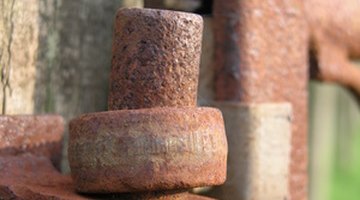Uses of Naval Jelly
Phosphoric acid in gel form is known as naval jelly, and the product has a variety of applications. Always use caution when working with naval jelly, as it is highly corrosive and caustic; use only in a well-ventilated area.

Rust Removal
Naval jelly is most commonly used to remove rust from iron or steel objects. Even very old, thick rust deposits can be removed with sanding or scraping, according to product websites. Naval jelly works simply by a generous application to the rust stain followed by a water rinse; if any rust remains, the procedure can be repeated, or light-gauge steel wool can be used.
Rust Proofing
Not only can naval jelly remove rust from iron and steel, but the gel can prevent the rust from forming. A thin amount should be spread over the surface of the at-risk steel or iron object and then rinsed. This process is most effective if repeated routinely.
Paint Preparation
Naval jelly can also be used to thoroughly clean iron or steel before applying paint as well as a paint preparation treatment for galvanized surfaces. The naval jelly should be applied with a paint brush or roller and left to treat the surface for up to 20 minutes. This completely cleans the surface of any rust. Since naval jelly is corrosive, if it is left on for a day or longer before it is removed, it will slightly etch the surface, creating a rougher texture that will more easily accept paint.
References
Writer Bio
Katherine Harder kicked off her writing career in 1999 in the San Antonio magazine "Xeriscapes." She's since worked many freelance gigs. Harder also ghostwrites for blogs and websites. She is the proud owner of a (surprisingly useful) Bachelor of Arts in English from Texas State University.
Photo Credits
- rust 2 image by Stanislav Halcin from Fotolia.com
- rust 2 image by Stanislav Halcin from Fotolia.com
More Articles



